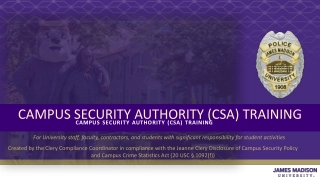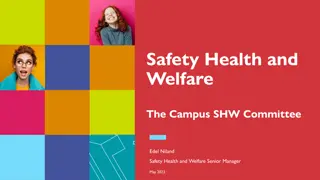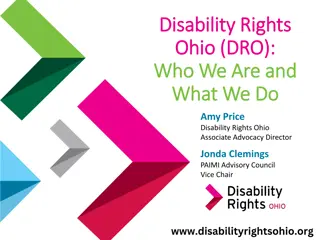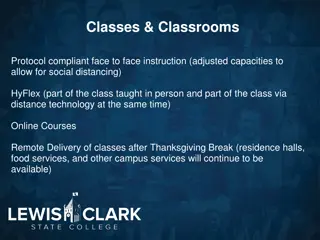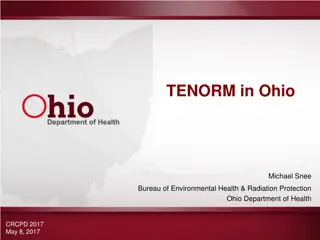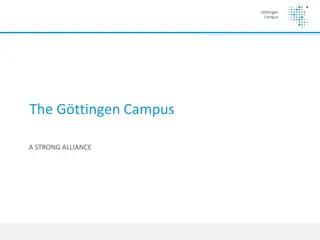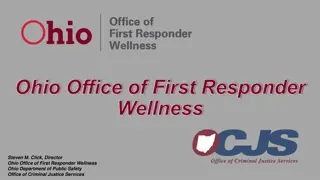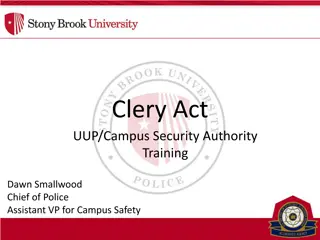Enhancing Campus Safety and Awareness in Ohio
Ohio aims to implement annual campus climate surveys to gather student perceptions on safety, guide initiatives, and provide relevant training to staff, faculty, students, and law enforcement. The goal is to enhance awareness, reduce sexual violence, and create a cohesive communication strategy across all campuses. By prioritizing data-driven decision-making and tailored training programs, Ohio plans to create a safer and more responsive educational environment for all stakeholders.
Download Presentation

Please find below an Image/Link to download the presentation.
The content on the website is provided AS IS for your information and personal use only. It may not be sold, licensed, or shared on other websites without obtaining consent from the author.If you encounter any issues during the download, it is possible that the publisher has removed the file from their server.
You are allowed to download the files provided on this website for personal or commercial use, subject to the condition that they are used lawfully. All files are the property of their respective owners.
The content on the website is provided AS IS for your information and personal use only. It may not be sold, licensed, or shared on other websites without obtaining consent from the author.
E N D
Presentation Transcript
Objective: By the start of the 2016-2017 academic year, 100 percent of Ohio s campuses will have developed and implemented an annual campus climate survey and defined next steps based on results. Implement annual campus climate survey to: Gain further insight into student s perceptions of campus safety Collect common data points Measure long-term progress Survey options: The Ohio Department of Higher Education will disseminate a common climate survey with baseline questions and provide technical support as needed. Campus will continue to use their existing survey with addition of common data points.
Survey results: 70 percent of respondents believe use of data to guide action is useful, yet only 27 percent of campuses responding to survey currently are implementing a data-driven strategy. There is great value in having a common tool that can be linked to statewide training and education programs. Disseminate the campus climate survey, with questions based on previous survey results. Allocate funds to analyze data from survey and use the data to guide future initiatives to change campus culture.
Objective: By the start of the 2016-2017 academic year, staff, faculty, students and law enforcement will receive training relevant to the most urgent issues identified in the campus climate survey, readiness assessment tool, or other forms of feedback (i.e. focus groups). A commitment to implement comprehensive training programs that best fit the needs of the campus that are identified by the campus climate survey (Recommendation 1) Comprehensive training programs include: Bystander training: Empowering the campus community to intervene if they think they are witnessing sexual violence. Self-protection: A study shows that college women receiving 12 hours of training were 46 percent less likely to be raped. Trauma-informed training: For campus responders, investigators and police builds trust and makes it easier to document the criminal act that occurred.
Survey results: 33 percent of responding campuses are already implementing this recommendation. I think it is important to be able to select programs or adapt programs to serve a particular campus culture. The campus s Title IX Coordinators and institutional policy makers will provide direction towards selecting the most appropriate comprehensive training programs. ODHE will coordinate bulk purchasing for campuses looking to purchase the same additional training. ODHE will contract with a consultant through an RFP to provide evidence- based training programs regionally.
Objective: By the start of the 2016-2017 academic year, every Ohio campus and university will have in place a cohesive communication and/or awareness program aimed at reducing sexual violence on campus. ODHE urges campuses to have in place a cohesive communication and/or awareness campaign by the beginning of next academic year that aims to shift thinking about sexual violence by inspiring everyone to see campus safety as their responsibility. Examples: It s On Us or Consent is Sexy
Survey results: Nearly half of all campuses that responded to the survey have an awareness plan in place, and 41 percent intend to implement this academic year. One size does not fit all. It is helpful to have evidence-based models and resources at low or no cost to the campuses. ODHE is implementing a resource portal through its ohiohighered.org website National campaigns such as It s On Us Highlight campaigns utilized by Ohio campuses such as Take Back the Night Provide examples of student programming
Objective: Every institution has a comprehensive sexual violence response protocol(similar to the comprehensive sexual misconduct protocol in the resources below) in place by the start of the 2016-2017 academic year. Campus should develop a comprehensive response protocol that works with their survivor-centered strategies and preserves the rights of the accused. A key objective of the comprehensive response protocol is to reduce barriers to reporting sexual violence.
Survey results: 35 percent of campuses have not completed to date. It would be extremely difficult to craft a protocol to fit the needs and structure of every institution statewide a statewide contract with a consultant to help campuses craft policies individually would be a huge benefit. A Safer Campus Guidebook located on ODHE s website provides more guidance on response protocols. Cultivate and share best practice documents on the resource portal such as templates from Notalone.gov. ODHE will contract with a consultant via RFP to support Ohio campuses without a comprehensive response protocol.
Objective: By the start of the 2016-2017 academic year, every campus will adopt one or more survivor-centered strategies and integrate those strategies into the comprehensive response protocol (see Recommendation #4). Campuses should identify responsible employees and confidential resources, both on and off campus, to provide a response that ensures survivors feel the ability to come forward and receive appropriate report services. Support services include: Confidential Advisor Victim Advocate Sexual Assault Response Guarantee
Survey results: 58 percent of campuses responding to the survey have NOT implemented a survivor-centered response; 33 percent said they would need longer than one year to do so. At this time we are finding it difficult to find resources in our counties to act as a victim advocate. ODHE will make confidential advisor training available and establish an RFP for a consultant to work with individual campuses. Through its resource portal, ODHE will provide examples and templates of memorandums of understanding that the college campuses can use to partner with their communities to provide survivor-centered services.
Disseminate a common campus climate survey Data analysis support of the campus climate surveys Coordinate bulk training programs Online resource portal Campus Sexual Violence Prevention Summit Individual grants


